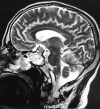Pituitary Prolactinoma with Amyloid Deposits: Surgery or Dopamine Agonists? Review of Previous Reports and New Recommendations for Management
- PMID: 31497097
- PMCID: PMC6703011
- DOI: 10.4103/ajns.AJNS_127_19
Pituitary Prolactinoma with Amyloid Deposits: Surgery or Dopamine Agonists? Review of Previous Reports and New Recommendations for Management
Abstract
Background: Pituitary adenomas, macro and micro, are a common occurrence in most neurosurgical centers. Prolactinomas are the most common pituitary tumors and are often treated nowadays with dopamine agonists such as cabergoline, with good results.
Aims and objectives: To suggest new therapeutic guidelines for treating Prolactinomas with Amyloid deposits on preoperative detection of Amyloid deposition in Pituitary tumors, based on MRI characteristics.
Materials and methods: We report a case of a pituitary prolactinoma with amyloid deposits in a 45-year-old male who underwent a transsphenoidal excision of the adenoma. Although on magnetic resonance imaging scans, no amyloid was reported, at histopathology, spherical amyloid within the pituitary tumor was found in abundance. The patient underwent surgery without any trial of cabergoline due to rapid deterioration of vision.
Conclusion: Prolactinomas with amyloid deposits are known not to respond to dopamine agonists (cabergoline) by a reduction in size and may ,in fact increase in volume. Therefore, we recommend that in prolactinomas not responding to medical therapy, deposition of amyloid has to be considered as a cause for failure of medical therapy and surgery and then has to be offered pronto.
Keywords: Amyloid; cabergoline; pituitary tumor; prolactin.
Conflict of interest statement
There are no conflicts of interest.
Figures





Similar articles
-
Occurrence of extensive spherical amyloid deposits in a prolactin-secreting pituitary macroadenoma: a radiologic-pathologic correlation.Ann Diagn Pathol. 2013 Aug;17(4):361-6. doi: 10.1016/j.anndiagpath.2013.03.001. Epub 2013 Apr 17. Ann Diagn Pathol. 2013. PMID: 23602507
-
Hormone levels and tumour size response to quinagolide and cabergoline in patients with prolactin-secreting and clinically non-functioning pituitary adenomas: predictive value of pituitary scintigraphy with 123I-methoxybenzamide.Clin Endocrinol (Oxf). 2000 Apr;52(4):437-45. doi: 10.1046/j.1365-2265.2000.00951.x. Clin Endocrinol (Oxf). 2000. PMID: 10762286 Clinical Trial.
-
The outcome of hypophysectomy for prolactinomas in the era of dopamine agonist therapy.Clin Endocrinol (Oxf). 1996 Jun;44(6):711-6. doi: 10.1046/j.1365-2265.1996.738559.x. Clin Endocrinol (Oxf). 1996. PMID: 8759184
-
Hyperprolactinemia: pathophysiology and management.Treat Endocrinol. 2003;2(1):23-32. doi: 10.2165/00024677-200302010-00003. Treat Endocrinol. 2003. PMID: 15871552 Review.
-
[Indications for surgical treatment of prolactin-secreting pituitary adenomas].Zh Vopr Neirokhir Im N N Burdenko. 2017;81(5):117-124. doi: 10.17116/neiro2017815117-124. Zh Vopr Neirokhir Im N N Burdenko. 2017. PMID: 29076475 Review. Russian.
Cited by
-
Medically responsive amyloidogenic giant sellar-parasellar prolactinoma.Surg Neurol Int. 2024 Apr 12;15:129. doi: 10.25259/SNI_150_2024. eCollection 2024. Surg Neurol Int. 2024. PMID: 38741982 Free PMC article.
-
The fatigue, sleep and physical activity in postoperative patients with pituitary adenoma: what we can do.Transl Cancer Res. 2020 Mar;9(3):1779-1786. doi: 10.21037/tcr.2020.02.47. Transl Cancer Res. 2020. PMID: 35117525 Free PMC article.
References
-
- Barr R, Lampert P. Intrasellar amyloid tumor. Acta Neuropathol. 1972;21:83–6. - PubMed
-
- Kuratsu J, Matsukado Y, Miura M. Prolactinoma of pituitary with associated amyloid-like substances. Case report. J Neurosurg. 1983;59:1067–70. - PubMed
-
- Landolt AM, Heitz PU. Differentiation of two types of amyloid occurring in pituitary adenomas. Pathol Res Pract. 1988;183:552–4. - PubMed
-
- Saitoh Y, Mori H, Matsumoto K, Ushio Y, Hayakawa T, Mori S. Accumulation of amyloid in pituitary adenomas. Acta Neuropathol. 1985;68:87–92. - PubMed
-
- Glenner GG, Eanes ED, Bladen HA, Linke RP, Termine JD. Beta-pleated sheet fibrils. A comparison of native amyloid with synthetic protein fibrils. J Histochem Cytochem. 1974;22:1141–58. - PubMed

